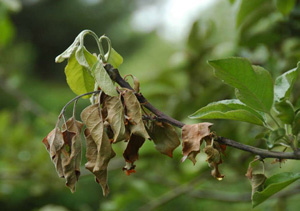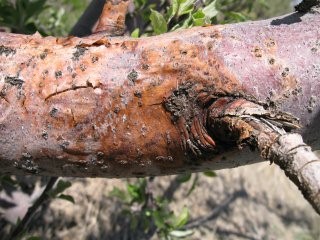Integrated Pest Management
Fire Blight of Ornamentals
Many ornamental plants of the Rose family are susceptible to a bacterial disease called fire blight. Ornamental members of this family include pyracantha, hawthorn, cotoneaster, mountain ash, and crabapple. This disease is generally more serious in pear and apple orchards because of the loss of production it causes. Damage to ornamentals is usually not economically important, but it can be extensive and unsightly. Flowers, fruit, and new leaves can be killed, as well as twigs and branches if the pathogen produces girdling cankers.
SYMPTOMS
Fire blight damage is typically first noticed when twigs wilt and die. Close examination of the wilted twig reveals flowers or leaves that appear to be scorched. Small droplets or strands of bacterial ooze may be present. Bacterial ooze is often a white, amber, or red liquid or is varnish-like upon drying. Other characteristic symptoms include a bacterial canker at the leading edge of the infection, and a shepherd's crook at the tip of the plant growth. Symptoms seen later in the season include a progressive wilting of the branch as the bacterial canker advances down the stem. Most infections occur through the flowers, preventing the development of berries on pyracantha or hawthorn.
DISEASE CYCLE
The bacterium, Erwinia amylovora, overwinters on the margins of cankers produced on twigs or branches. The pathogen becomes active in the spring and begins to ooze out of the margins of cankers. The bacteria in the ooze are transported to flowers by splashing rain or insects. The bacteria multiply on the exterior of floral parts, but infection generally does not occur until rain or heavy dew move the bacteria to infection sites in the flower. Infected flowers wilt rapidly and turn brown or black. Small droplets of bacterial ooze may be visible on infected tissue. The infection may progress into the spur, twig, or branch, depending on the susceptibility of the host.
Infections may also occur in tender stem and leaf tissues. Hail or sucking insects injure the plant and allow the bacteria to gain entrance into twigs.
MANAGEMENT
Cultural techniques are important for the control of fire blight. Avoid overfertilizing with nitrogen. Excessive fertilizer promotes new growth which is more susceptible to fore blight infections. Do not sprinkle irrigate susceptible plants --it spreads bacteria. During dormancy, inspect plants carefully for any cankers or blighted twigs. Remove and destroy infected tissues. Make cuts 8-12 inches below any visible cankers. Prune out infected stems in the spring if the infection is progressing into larger twigs or branches. Dispose of infected plant parts by burning or in the trash. Bactericides need only be applied during flowering when plants are most likely to be infected. Start applications when the daily mean temperature exceeds 62 F (average maximum and minimum temperature from midnight to midnight) and repeat every 5 days. Treatments are only necessary when rain occurs during bloom period. Effective bactericides are streptomycin sulfate (Agimycin 17) and fixed coppers (e.g. Bordeaux, basic copper sulfate, copper oxychloride, copper oxide, and copper hydroxide). Follow label directions listed for ornamentals.



